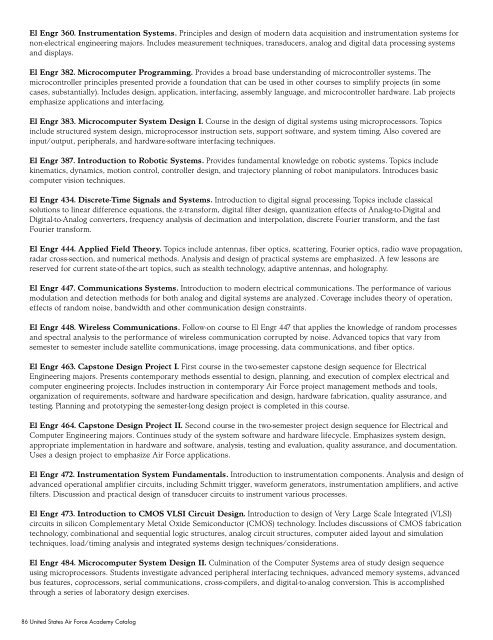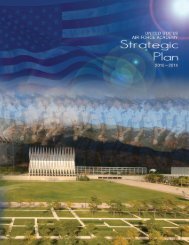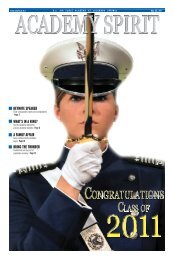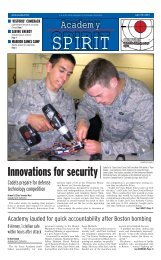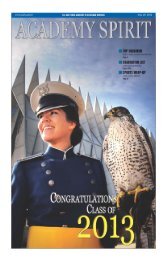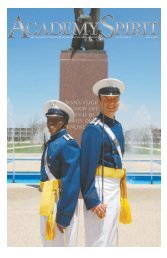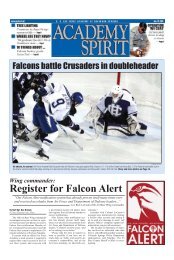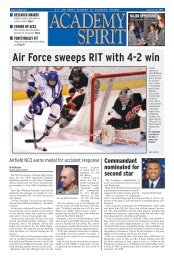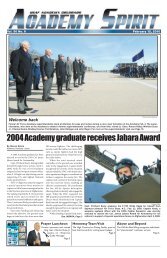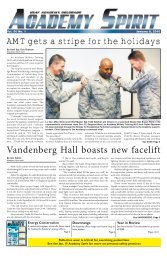2008-2009 Catalog - United States Air Force Academy
2008-2009 Catalog - United States Air Force Academy
2008-2009 Catalog - United States Air Force Academy
You also want an ePaper? Increase the reach of your titles
YUMPU automatically turns print PDFs into web optimized ePapers that Google loves.
El Engr 360. Instrumentation Systems. Principles and design of modern data acquisition and instrumentation systems for<br />
non-electrical engineering majors. Includes measurement techniques, transducers, analog and digital data processing systems<br />
and displays.<br />
El Engr 382. Microcomputer Programming. Provides a broad base understanding of microcontroller systems. The<br />
microcontroller principles presented provide a foundation that can be used in other courses to simplify projects (in some<br />
cases, substantially). Includes design, application, interfacing, assembly language, and microcontroller hardware. Lab projects<br />
emphasize applications and interfacing.<br />
El Engr 383. Microcomputer System Design I. Course in the design of digital systems using microprocessors. Topics<br />
include structured system design, microprocessor instruction sets, support software, and system timing. Also covered are<br />
input/output, peripherals, and hardware-software interfacing techniques.<br />
El Engr 387. Introduction to Robotic Systems. Provides fundamental knowledge on robotic systems. Topics include<br />
kinematics, dynamics, motion control, controller design, and trajectory planning of robot manipulators. Introduces basic<br />
computer vision techniques.<br />
El Engr 434. Discrete-Time Signals and Systems. Introduction to digital signal processing. Topics include classical<br />
solutions to linear difference equations, the z-transform, digital filter design, quantization effects of Analog-to-Digital and<br />
Digital-to-Analog converters, frequency analysis of decimation and interpolation, discrete Fourier transform, and the fast<br />
Fourier transform.<br />
El Engr 444. Applied Field Theory. Topics include antennas, fiber optics, scattering, Fourier optics, radio wave propagation,<br />
radar cross-section, and numerical methods. Analysis and design of practical systems are emphasized. A few lessons are<br />
reserved for current state-of-the-art topics, such as stealth technology, adaptive antennas, and holography.<br />
El Engr 447. Communications Systems. Introduction to modern electrical communications. The performance of various<br />
modulation and detection methods for both analog and digital systems are analyzed. Coverage includes theory of operation,<br />
effects of random noise, bandwidth and other communication design constraints.<br />
El Engr 448. Wireless Communications. Follow-on course to El Engr 447 that applies the knowledge of random processes<br />
and spectral analysis to the performance of wireless communication corrupted by noise. Advanced topics that vary from<br />
semester to semester include satellite communications, image processing, data communications, and fiber optics.<br />
El Engr 463. Capstone Design Project I. First course in the two-semester capstone design sequence for Electrical<br />
Engineering majors. Presents contemporary methods essential to design, planning, and execution of complex electrical and<br />
computer engineering projects. Includes instruction in contemporary <strong>Air</strong> <strong>Force</strong> project management methods and tools,<br />
organization of requirements, software and hardware specification and design, hardware fabrication, quality assurance, and<br />
testing. Planning and prototyping the semester-long design project is completed in this course.<br />
El Engr 464. Capstone Design Project II. Second course in the two-semester project design sequence for Electrical and<br />
Computer Engineering majors. Continues study of the system software and hardware lifecycle. Emphasizes system design,<br />
appropriate implementation in hardware and software, analysis, testing and evaluation, quality assurance, and documentation.<br />
Uses a design project to emphasize <strong>Air</strong> <strong>Force</strong> applications.<br />
El Engr 472. Instrumentation System Fundamentals. Introduction to instrumentation components. Analysis and design of<br />
advanced operational amplifier circuits, including Schmitt trigger, waveform generators, instrumentation amplifiers, and active<br />
filters. Discussion and practical design of transducer circuits to instrument various processes.<br />
El Engr 473. Introduction to CMOS VLSI Circuit Design. Introduction to design of Very Large Scale Integrated (VLSI)<br />
circuits in silicon Complementary Metal Oxide Semiconductor (CMOS) technology. Includes discussions of CMOS fabrication<br />
technology, combinational and sequential logic structures, analog circuit structures, computer aided layout and simulation<br />
techniques, load/timing analysis and integrated systems design techniques/considerations.<br />
El Engr 484. Microcomputer System Design II. Culmination of the Computer Systems area of study design sequence<br />
using microprocessors. Students investigate advanced peripheral interfacing techniques, advanced memory systems, advanced<br />
bus features, coprocessors, serial communications, cross-compilers, and digital-to-analog conversion. This is accomplished<br />
through a series of laboratory design exercises.<br />
86 <strong>United</strong> <strong>States</strong> <strong>Air</strong> <strong>Force</strong> <strong>Academy</strong> <strong>Catalog</strong>


